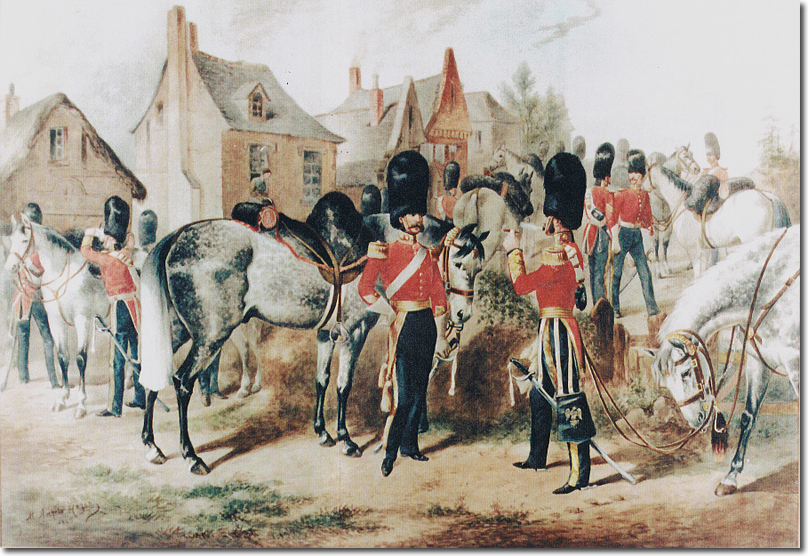|
|


|
|
The Greys were in Ireland from 1836 to 1843, and 1846 to 1851. Michael Angelo Hayes observed the regiment at first hand and was able to make accurate paintings of their uniforms and equipment. The scene is a village where the officers and men are having a rest. Their uniforms are extremely smart for such a potentially dusty undertaking as marching and perhaps the regiment has persuaded the artist to show them at their best. The bearskins are without plumes as they were dispensed with in 1843 but re-introduced in 1845. Either they had not received their plumes or else they have been removed. They have no visible gilt attachments to the bearskin. The paintings by Hayes of the earlier period show a flaming bomb badge on the front and also on the side for the plume to be fixed. The coatees are well covered with gold lace on the sleeves and collars, and the officers' collars have gold embroidered flaming bomb badges. The officers also have gold epaulettes and a white leather undress pouch-belt and undress black pouch with a gilt Eagle badge. This badge is also to be seen on the black undress sabretache. Around the officers' waists are fine gold and crimson silk sashes with long tassels hanging on the right side. The 1832 Drahonet painting of the lieutenant-colonel shows the tassels on the left side. The sash also covers the waist-belt.
The undress saddles have a black sheepskin cover with red edge, and a red valise on the back. This is no different from the 1832 undress saddle seen in a Spooner print, but in 1847 the shabraque was discontinued so what we see here would soon be the dress version of horse furniture. What is different from the 1830s is the bridle which no longer has the cross straps on the horse's face, and has a black and red horsehair throat-plume. The officers are once more sporting moustaches, as are the men, after they were banned during the 1830s. The men in the background give us some information. The tails of their coatees are quite long but in 1847 they were shortened. They do not carry sabretaches; other ranks of the heavy cavalry had stopped wearing these at this time so that only hussars had them. The sergeant with his back to us talks to a man who does not have a pouch-belt. This must be a trumpeter although there are no other signs to indicate this, no brass epaulettes and no aiguillettes as in the previous decade. |
Armed Forces | Art and Culture | Articles | Biographies | Colonies | Discussion | Glossary | Home | Library | Links | Map Room | Sources and Media | Science and Technology | Search | Student Zone | Timelines | TV & Film | Wargames